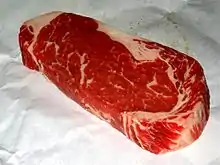Roast beef
Roast beef is a traditional English dish of beef which is roasted. Essentially prepared as a main meal, the leftovers are often used in sandwiches and sometimes are used to make hash. In the United Kingdom, United States, Canada, Ireland, South Africa, New Zealand, and Australia, roast beef is one of the meats traditionally served at Sunday lunch or dinner, although it is also often served as a cold cut in delicatessen stores, usually in sandwiches. A traditional side dish to roast beef is Yorkshire pudding.
.JPG.webp) | |
| Course | Main course |
|---|---|
| Place of origin | England |
| Serving temperature | Hot or Cold |
| Main ingredients | Beef |
| Part of a series on |
| Steak |
|---|
 |
Roast beef is a signature national dish of England and holds cultural meaning for the English dating back to the 1731 ballad "The Roast Beef of Old England". The dish is so synonymous with England and its cooking methods from the 18th century that a French nickname for the English is "les Rosbifs".[1]
History
Despite the song, roast beef was not generally eaten in medieval England: "no medieval feast featured ... roast beef, even in England".[2]
Culinary arts
The beef on weck sandwich is a tradition in western New York dating back to the early 1800s.[3] Roast beef is sometimes served with horseradish or horseradish sauce. In Denmark, it is mostly used in open sandwiches, called smørrebrød.
Roast beef sandwich
The roast beef sandwich commonly comprises bread, cold roast beef (either the leftovers from a homemade dinner or delicatessen meat), lettuce, tomatoes, and mustard, although finding cheese, horseradish, fresh/powdered chili pepper, and red onion would not be uncommon.[4]
Gallery

 Some prefer roast beef to be served "medium"
Some prefer roast beef to be served "medium" Roast beef sandwich
Roast beef sandwich Roast beef
Roast beef
References
- "Why do the French call the British 'the roast beefs'?". BBC. Retrieved 25 November 2014
- Rachel Fulton, "'Taste and See That the Lord Is Sweet' (Ps. 33:9): The Flavor of God in the Monastic West", The Journal of Religion 86:2:169–204 (2006) doi:10.1086/499638, p. 171
- Piatti-Farnell, Lorna (2013-06-01). Beef: A Global History. Reaktion Books. ISBN 9781780231174.
- "MyRecipes.com" Archived 2009-11-24 at the Wayback Machine